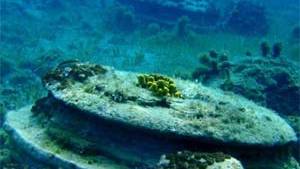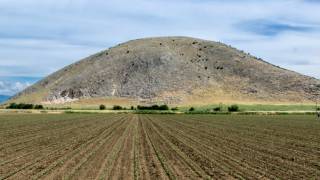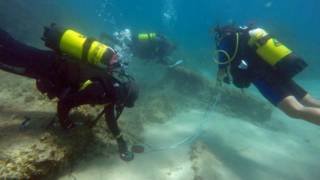Zakynthos - Cover up of a lost Greek city?
Source: ancient-origins.net
Finder of Zakynthos ruins refutes natural phenomenon claimLast month we reported on a study which claimed that the ancient ruins of Zakynthos in Greece are nothing but a natural phenomenon. It was a strange u-turn considering that the Underwater Antiquities Department had announced that the original discovery included huge public buildings, cobblestone paving, bases for pillars and other building materials. We raised a question about whether this new study was authentic or whether there were attempts to suppress the original findings. So we asked the man who first found the site, Pavlos Voutos, to share his perspective.
---
About 25 years ago, I started diving in the clear blue waters of Zakynthos. Many times I passed through the water seeing small broken pieces of ceramics and I asked myself where they were from. I thought that maybe there was something buried in the sand. I believed that there was definitely something ancient around the area that deserved more investigation. For many years I didn’t find any other clues to prove this.
My love for the sea made me buy an underwater camera to start taking photographs of my diving excursions. It was then that the secret was revealed to my eyes. One day, I photographed some small colourful fish and later, when I was looking at the photographs on my computer, I realised that some of the stones behind the fish had shapes and lines that looked man made.
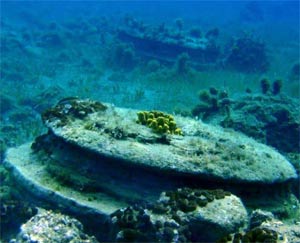 After searching a little bit better in a place with bad visibility, which I had previously avoided, I found the rest of the stones, round bases of columns, small columns, mill stones, huge square-shaped stones, shaped eaves (even today we still use them in stone buildings above windows and doors), and three rows which look like paths and are completely straight. Each row is about 200 meters long and two of them are completely parallel. I realized that many fishermen with nets had been in the area and caught Amphora but no one knew what was down there.
After searching a little bit better in a place with bad visibility, which I had previously avoided, I found the rest of the stones, round bases of columns, small columns, mill stones, huge square-shaped stones, shaped eaves (even today we still use them in stone buildings above windows and doors), and three rows which look like paths and are completely straight. Each row is about 200 meters long and two of them are completely parallel. I realized that many fishermen with nets had been in the area and caught Amphora but no one knew what was down there.Then started my adventure with the authorities, who neither believed me nor cared. So I decided to upload some photographs on Google earth. After a couple of years, the Vice Mayor of Zakynthos discovered them and called me to meet, and to show and tell him more. Everyone in that meeting was impressed and immediately decided to call the underwater archeologists. They came after about a month and we met in front of a committee of about fifteen people. They saw the photographs and they spoke about the clear indications that they were ancient ruins.
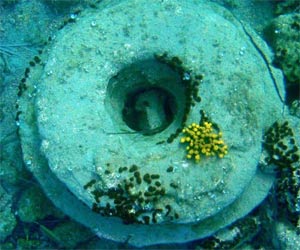 Over the next few days we returned to the area for diving. The archaeologists were very excited and they talked about a big ancient building of significance. On that dive they took out a round stone with a hole in it and, after examining it, concluded that it was a mill stone. They then returned it to where it was found. They also did a couple of dives on their own and gave us another appointment to come back in October 2013 to do a more complete research. They made an official announcement of the finding on the Ministry of Culture website using my photographs and describing the stones and rows as indicative of ancient ruins. The Director of the Underwater Archeology Department was interviewed on the government’s National TV channel showing my photographs (without naming them as mine). They hid my identity, even when asked by the reporters.
Over the next few days we returned to the area for diving. The archaeologists were very excited and they talked about a big ancient building of significance. On that dive they took out a round stone with a hole in it and, after examining it, concluded that it was a mill stone. They then returned it to where it was found. They also did a couple of dives on their own and gave us another appointment to come back in October 2013 to do a more complete research. They made an official announcement of the finding on the Ministry of Culture website using my photographs and describing the stones and rows as indicative of ancient ruins. The Director of the Underwater Archeology Department was interviewed on the government’s National TV channel showing my photographs (without naming them as mine). They hid my identity, even when asked by the reporters.When they came back in October, the atmosphere had completely changed. The archaeologists and rest of the team seemed uninterested, stressed and upset with everything and everybody. In June, they had told us that they would bring a group of diving scientists, archeologists, topographers, architects, geologist and an artist to make the underwater map of the area. Instead only one of the archeologist divers and three escort divers came to re-examine the area. That was surprising to me. They also complained to us that we had given a lot of publicity to the finds, however it was them that made the announcement on National TV.
During the dive in October, they didn’t want anyone to go close to them, not even me, and they specifically mentioned that they didn’t want any reporters there. After a few days of diving and before the geologists came, a local fisherman brought a piece of ancient stone which he had caught in his nets in the area. He broke it in front of them shouting to go away because it’s a geological phenomenon and it’s not their business to be there.
[...]
Read the full article at: ancient-origins.net
